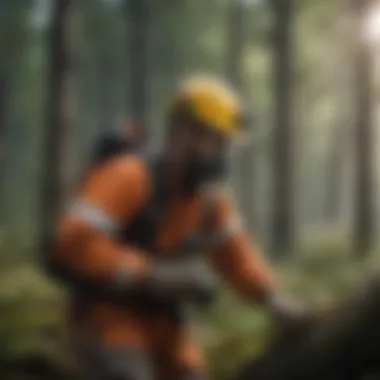Wildland Extrication Gear: Tools for Safety


Intro
The intricate interrelation between humanity and nature is exemplified in the context of wildland extrication. Being equipped with the right gear ensures safety not only for forestry professionals but also for the ecosystems they protect. In emergency scenarios within forests, having the appropriate tools can mean the difference between successful rescue operations and potential disasters. This article aims to shed light on the vital gear necessary for these challenging situations and underlines their integral role in maintaining the delicate balance of woodland environments.
Understanding Woodland Ecosystems
Understanding woodland ecosystems transcends awareness of trees and wildlife; it requires a nuanced appreciation of biodiversity and climate regulation. Forests serve as lungs for the planet, absorbing carbon dioxide and releasing oxygen. The diverse life forms within wooded areas, ranging from flora to fauna, contribute to this capability in significant ways.
Importance of Biodiversity in Forests
Biodiversity within forests is crucial for ecological resilience. Healthy ecosystems rely on a variety of species to maintain balance. This diversity not only supports wildlife habitats but also promotes the integrity of soil, water, and air quality. When crises unfold in these environments, such as wildfires or storms, biodiversity plays a key role in recovery, enabling ecosystems to bounce back more effectively.
Role of Forests in Climate Regulation
Forests are vital in mitigating climate change impacts. They regulate temperature, store carbon, and affect local weather patterns. When considering wildland extrication operations, it's imperative to adopt practices that sustain forest health. Protecting these ecosystems through informed decisions about gear and techniques can aid in long-term conservation efforts.
Sustainable Forestry Practices
Implementing sustainable forestry practices forms the backbone of responsible woodland management. It enriches biodiversity and ensures forest ecosystems remain healthy for future generations.
Principles of Sustainable Forestry
Some core principles of sustainable forestry include:
- Maintaining ecosystem health: Ensure diverse species flourish and ecosystems function effectively.
- Responsible harvesting: Limit resource extraction to sustainable levels.
- Community engagement: Foster local involvement in forest management practices.
By following these principles, forestry professionals can better handle emergency situations while simultaneously advocating for the forest's survival.
Case Studies of Successful Implementations
Real-world examples illuminate the impact of sustainable practices. For instance, initiatives in Oregon and Washington demonstrate how multi-stakeholder approaches can restore degraded forest areas through careful management. These cases reveal the potential of effective extrication gear to support recovery efforts in conjunction with sustainable practices.
Woodland Stewardship Techniques
Woodland stewardship techniques encompass numerous strategies that promote forest health and safety during emergencies. Effective navigation of these techniques requires thorough understanding and planning.
Forest Management Plans
A comprehensive forest management plan is fundamental. This document outlines strategies for maintaining forest health, guiding timber harvests, and bolstering ecological restoration activities. Proper pruning, thinning, and regeneration practices fortify forests against the threat of catastrophic events.
Conservation Strategies
Implementing conservation strategies includes:
- Protecting critical habitats: Ensures species survival and ecosystem balance.
- Restoration efforts: Revitalizing areas affected by disturbances helps restore biodiversity.
- Collaborative management: Engaging communities in conservation fosters a collective sense of responsibility.
These techniques and strategies underscore the importance of thoughtful engagement with our forest ecosystems, especially during emergencies. Gear is not merely tools; it is an essential part of a broader strategy aimed at ensuring safety and environmental sustainability.
Preamble to Wildland Extrication Gear
Wildland extrication gear plays a crucial role in maintaining safety during forestry operations, particularly in emergency situations. Without the correct tools and equipment, the risks associated with these endeavors increase significantly. The very essence of this gear is not only to assist in removing individuals from perilous situations, but also to protect the responders themselves. This section delves into the definition of wildland extrication gear and highlights its importance in forestry.
Definition and Purpose
Wildland extrication gear refers to specialized tools and equipment designed for safely rescuing individuals from difficult terrains and hazardous conditions found in forested environments. This gear encompasses a wide range of tools, including cutting devices, climbing apparatus, and personal safety equipment. Its primary purpose is to provide support and safety measures during emergency extrication operations. This support extends not only to those in distress but also to the professionals who engage in rescue efforts.
Having proper gear allows for efficient operations, minimizes hazards, and potentially saves lives. Rescue missions can involve significant physical challenges, so using reliable equipment is essential in managing such risks. It is also worth noting that the dynamics of forestry require responders to have agile and adaptable tools that can function effectively in diverse conditions.
Importance of Extrication Gear in Forestry
The importance of extrication gear in forestry cannot be overstated. Forests can present a multitude of dangers such as difficult terrain, weather changes, and the presence of wildlife. Here are some key points that underline its significance:
- Safety Assurance: Proper gear ensures the safety of both the rescuer and the individual needing assistance.
- Operational Efficiency: Equipped responders can execute their tasks more effectively, reducing the time spent in dangerous environments.
- Environmental Respect: Using appropriate tools limits the environmental impact during extrication, sustaining forest ecosystems.
- Learning and Adaptation: As techniques evolve, so does the technology behind extrication gear, necessitating continuous education and equipment updates for forestry professionals.
"Wildland extrication gear does not just facilitate rescues; it embodies the safety culture that is paramount in forestry environments."
In essence, the significance of wildland extrication gear in forestry lies not only in its physical components but also in the culture of safety and preparedness it fosters. This preparation and understanding ultimately drive effective extrication operations. A well-informed approach to selecting and utilizing this gear enhances overall safety and effectiveness in the face of potential dangers.
Types of Wildland Extrication Gear
In the realm of wildland extrication, the appropriate gear is crucial for both safety and efficiency. The right tools can make a significant difference in emergency situations. Understanding the different types of wildland extrication gear helps professionals act quickly and competently in complex environments. Each piece of equipment serves a unique purpose and is designed to tackle specific challenges inherent in forested settings.
Climbing and Rigging Equipment
Climbing and rigging equipment is fundamental for safely accessing difficult terrains in wildland operations. Items such as ropes, carabiners, and pulleys aid in ascent and movement during rescues. These tools must meet stringent safety standards, as they carry the potential for life-saving applications.
Key components include:


- Static and Dynamic Ropes: Static ropes provide stability for ascending or descending, while dynamic ropes absorb shock during falls.
- Harnesses: A well-fitted harness offers necessary support and distributes weight evenly, which is crucial for prolonged use.
- Pulleys: Pulleys facilitate mechanical advantage, making it easier to lift or move heavy weights, essential for extricating individuals trapped in challenging situations.
Incorporating climbing and rigging gear into operations not only enhances safety but also increases the potential for successful extrication in a timely manner.
Cutting Tools and Equipment
Cutting tools are indispensable in wildland extrication, as they enable responders to clear obstacles and gain access to stranded individuals. Chainsaws, hand saws, and axes are typical examples of equipment in this category. Each tool has its application, determined by the type of vegetation or debris involved.
The benefits of using appropriate cutting tools include:
- Versatility: Tools like chainsaws can handle larger trees, while hand saws are more efficient for smaller tasks.
- Portability: Many cutting tools are lightweight and designed for easy transport, allowing teams to operate efficiently.
- Safety Features: Modern cutting equipment often includes safety features that minimize risks of injury during use.
The efficacy of cutting tools directly correlates to the speed of response and effectiveness of the operation overall.
Safety Apparel and Gear
Safety apparel is a non-negotiable aspect of extrication gear. Appropriate clothing and protective equipment ensure responders are shielded from potential hazards. Fire-resistant clothing, helmets, gloves, and eye protection are just some examples of protective gear necessary for forestry operations.
Factors to consider include:
- Material Quality: High-quality materials offer durability and resistance to environmental factors, which is important when working in unpredictable settings.
- Fit and Comfort: Properly fitted safety apparel allows for ease of movement without sacrificing protection.
- Visibility: Bright colors or reflective strips enhance visibility in low-light situations, improving responder safety.
Effective safety apparel forms the first line of defense against the inherent dangers in wildland extrication missions.
Harnesses and Belay Devices
Harnesses and belay devices are essential in ensuring safety when working at heights or in precarious positions. A high-quality harness securely supports the individual's weight while the belay device helps manage rope tension.
Key points include:
- Types of Harnesses: Full-body harnesses offer greater support and are often recommended for challenging extrication scenarios.
- Belay Device Functionality: These devices provide controlled descent and can help catch a fall, adding a critical layer of safety to any climbing operation.
- Compatibility: It is vital that harnesses and belay devices are compatible and regularly inspected for wear and tear.
Properly selected and used harnesses and belay devices prevent serious injuries in risky forestry operations, contributing significantly to overall safety.
"Investing in quality wildland extrication gear is not just a precaution; it is an investment in the safety and success of forestry operations."
In summary, the types of wildland extrication gear are diverse and crucial for enhancing safety and effectiveness in complex forestry operations. Each piece of equipment plays a role in addressing specific challenges presented by the environment.
Selecting Appropriate Gear
Choosing the right wildland extrication gear is paramount in ensuring both safety and efficacy during emergency responses. The process of selecting appropriate gear involves several layers of decision-making that can impact outcomes in critical situations. It's not just about having gear on hand; rather, it encompasses a systematic approach toward understanding the environment and operational needs. Considerations such as situational awareness, equipment performance, and cost-effectiveness play significant roles in this selection process.
Assessing Environmental Conditions
Before deciding on gear, it is important to evaluate the environmental conditions where the extrication will take place. Factors like weather patterns, terrain type, and potential hazards will influence the choice of equipment. For instance, if the operation involves steep slopes or rocky terrains, specialized climbing gear becomes essential. Similarly, in wet conditions, waterproof gear can prevent injuries or equipment failure.
Consider the following:
- Weather: Is it hot or cold? Rainy or dry?
- Terrain: Are there steep cliffs or dense forests?
- Visibility: Will it be day or night during the operation?
Each of these elements affects not just safety but also the overall effectiveness of the operations conducted.
Understanding Gear Specifications
Each piece of wildland extrication gear comes with distinct specifications that dictate its suitability for various tasks. Understanding these specifications is crucial for effective use. For instance, the weight, strength ratings, and material composition of harnesses can determine their performance under load. Not only should gear meet industry standards, but it should also align with personal user needs and the unique aspects of the operation at hand.
When choosing gear:
- Verify safety certifications.
- Assess weight limits appropriate for individuals.
- Check for durability ratings against known conditions.
By having a clear understanding of these specifications, forestry professionals can make informed choices that ensure both safety and efficiency during operations.
Cost vs. Quality Considerations
A common dilemma in selecting extrication gear often revolves around cost versus quality. While high-quality gear tends to be more expensive, it usually provides better durability and reliability. However, budget constraints can make the decision difficult.
To navigate this issue, evaluate:
- The potential risks associated with using lower-quality gear.
- The likelihood of needing replacements or repairs over time.
- Long-term investments in safety versus short-term savings.
Ultimately, investing in quality gear could yield better outcomes during high-stakes situations. Prioritize gear that not only meets safety standards but also fits your operational specifics.
By factoring in environmental conditions, understanding gear specifications, and balancing cost against quality, professionals can effectively select appropriate gear that meets the demands of their work in forestry and safety-related extrication operations.
The Role of Technology in Extrication Gear
Technology plays a pivotal role in the evolution of wildland extrication gear, significantly enhancing safety and efficiency in emergency situations. Modern developments in material science and the integration of smart technologies have changed how forestry professionals approach extrication operations. Understanding this role is essential, as it underlines the importance of adopting advanced tools and techniques for effective emergency response in forested areas.
Advancements in Material Science


Recent advancements in material science have led to the creation of lightweight and durable materials for extrication gear. This progress allows for tools and equipment that are both effective and manageable in the demanding environment of wildland firefighting or rescue operations. For instance, high-strength synthetic fibers, such as Kevlar and Dyneema, enhance the performance of ropes and harnesses, making them more resistant to abrasion and environmental factors.
Another notable advancement is the development of fire-retardant fabrics that protect against high temperatures while maintaining breathability. Gear made from such materials offers vital protection to forestry workers who may face unpredictable fire behavior. In addition, innovations in the design of personal protective equipment—such as helmets, gloves, and suits—have not only improved safety but also increased comfort, allowing users to perform their tasks effectively for extended periods without significant fatigue.
Integration of Smart Technologies
The integration of smart technologies into wildland extrication gear has introduced new dimensions of safety and efficiency. Wearable technology, including GPS devices and communication systems, enables teams to maintain contact and coordinate their efforts effectively during operations. Smart helmets with built-in communication systems facilitate constant dialogue among crew members, which ensures better decision-making in critical situations.
Moreover, advancements in drone technology provide aerial surveillance capabilities, allowing responders to assess situations from above. This ability to gather real-time data helps teams devise more strategic approaches to rescue and fire management operations.
"The future of forestry safety lies in a conjunction of expertise and technology, making it imperative for professionals to keep abreast of these innovations."
As smart technologies evolve, there is the potential for further improvements. For instance, augmented reality (AR) could be used to overlay important safety information in the user’s field of vision, enhancing situational awareness. Those in the forestry sector must be prepared to embrace these tools, as they offer invaluable support in high-risk environments, ultimately improving survival rates and operational success.
In closing, the role of technology in extrication gear is vital. Ongoing advancements in material science and smart technologies continue to redefine standards and expectations, necessitating a commitment from forestry professionals to stay informed and adaptable.
Training and Education for Proper Use
Training and education play a pivotal role in ensuring the effective utilization of wildland extrication gear. This emphasis on education helps forestry professionals understand both the functionality of their tools and the critical nature of safety protocols during emergency situations. Lack of proper training can result in mismanagement of the equipment, leading to severe consequences during extrication missions. Therefore, developing a strong foundation through education empowers workers in the field to make informed decisions that can save lives.
The benefits of focused training programs are extensive. Firstly, they bolster confidence among professionals who are tasked with challenging rescue operations. Knowing how to properly use gear, including cutting tools and climbing equipment, is essential for effective results. Moreover, proper education minimizes risks associated with injuries. When individuals understand the potential hazards and know how to mitigate them, they can decrease the likelihood of accidents.
It is also important to consider the ongoing nature of education in this field. As technology and techniques evolve, so must the training programs. Continuous learning allows individuals to stay updated on best practices and innovations in gear development, further enhancing safety and operational efficiency.
Certification Programs for Professionals
Certification programs provide forestry professionals with structured learning experiences that validate their skills and knowledge regarding wildland extrication gear. Organizations often create well-defined curriculum focusing on key aspects such as equipment handling, safety measures, and risk management. By obtaining certification, individuals demonstrate competence in a specialized area, which can be crucial during hiring processes or when taking on new responsibilities.
These programs usually involve both theoretical knowledge and practical applications, ensuring a well-rounded education. Applicants might learn not only how to use specific tools but also how to assess situations critically and adapt their approach accordingly.
Employers tend to prioritize candidates with certifications, knowing that they offer a clear indication of a professional's proficiency. Furthermore, the collaboration with accredited institutions ensures that the training adheres to industry standards, affirming its legitimacy.
Hands-On Training Exercises
Hands-on training exercises are integral to the education of wildland extrication professionals. They transform theoretical knowledge into practical skills, allowing individuals to practice using gear in safe but realistic settings. These exercises often simulate emergency scenarios, which help participants learn to manage stress and think critically under pressure.
During these training sessions, participants can familiarize themselves with the equipment's mechanics and operations. This familiarity reduces hesitation when actual scenarios arise. Practicing proper procedures also enhances muscle memory, improving the response times and efficiency of professionals when every second counts.
Moreover, engaging in hands-on exercises fosters teamwork. Professionals often work in groups during training, which mirrors real-world operations where collaboration is crucial. This aspect of training reinforces communication skills, coordination, and trust among team members.
Best Practices for Effective Use
In the realm of wildland extrication operations, best practices are not merely recommendations; they are essential protocols that promote safety, efficiency, and success. Ensuring that all gear is utilized correctly can drastically improve outcomes in emergency situations. These practices serve a dual purpose: safeguarding the individuals involved and enhancing the overall effectiveness of the response efforts. By acknowledging and implementing best practices, forestry professionals can mitigate risks and navigate the complexities of wilderness rescues more confidently.
Pre-Operation Checklists
Before commencing any extrication operation, a thorough pre-operation checklist is crucial. This checklist acts as a methodical guide to ensure that all equipment and safety measures are accounted for. The following elements are typically included in a comprehensive pre-operation checklist:
- Gear Inspection: Examine all tools and equipment for physical damage or wear. This includes checking harnesses, ropes, and cutting tools for any signs of wear and tear.
- Functionality Tests: Conduct functional tests on critical gear, such as belay devices and emergency communication devices, ensuring they are working correctly.
- Environmental Assessment: Review weather conditions and potential hazards in the area. This helps in making informed decisions regarding the operation.
- Team Briefing: Organize a briefing session with all team members to discuss roles, responsibilities, and the action plan.
These steps, while simple, lay a vital foundation for safe and effective operations in unpredictable forest environments. Adhering to a checklist minimizes the likelihood of oversights that could lead to dangerous situations.
Emergency Response Protocols
When an emergency occurs, having clear protocols in place is fundamental. These protocols guide teams in responding quickly and effectively, ensuring maximum safety and efficiency. Key aspects of emergency response protocols include:
- Clear Communication: Establishing a system for communication among team members can prevent confusion. Use radios or other reliable communication tools to maintain contact.
- Defined Roles: Each team member should have a specific role during the response operation. Clarity in duties helps streamline efforts and improves coordination during emergencies.
- Safety Measures: Always prioritize safety. Assign a safety officer who monitors the well-being of the team and assesses risks continuously throughout the operation.
- Post-Incident Review: Conduct a review after the operation to analyze what went well and identify areas for improvement. This reflection can lead to better preparedness for future incidents.
Emergency situations require precision and effectiveness. Having established protocols minimizes chaos and maximizes safety.
Through these recommended best practices, forestry professionals can optimize their response capabilities, ensuring that both the team and the individuals they are reaching out to are protected. Implementing these practices is not just about complying with standards; it is about embodying a proactive safety culture that can save lives.
Case Studies: Successful Extrication Operations
Analyzing successful extrication operations provides invaluable insights for forestry professionals. These case studies highlight real scenarios where wildland extrication gear played a crucial role in ensuring safety and effectiveness during emergencies. Moreover, they underline the significance of proper training and preparedness in various situations.
Through thorough examination, there are several benefits to studying these incidents:
- Learning from Experience: Case studies allow professionals to reflect on past operations. This learning process helps to identify best practices and potential pitfalls.
- Improving Strategies: Each case offers unique challenges and solutions. Documenting these instances enables continual improvement in extrication strategies.
- Justifying Gear Investments: Understanding real-world applications of gear can help justify investments in high-quality equipment.
By dissecting examples of successful extrications, one can ascertain not only what worked but also why it worked. In this regard, applying knowledge from case studies can enhance overall preparedness.
Incident Analysis and Lessons Learned
Conducting incident analysis involves a systematic review of successful extrication operations. It encompasses examining the methods, equipment utilized, and actions taken by responders. Lessons learned from incidents provide a pathway to improving future responses.
Factors worth analyzing include:


- Decision-Making: How decisions were made on the ground can reveal best practices in critical thinking under pressure.
- Team Coordination: Effective communication and teamwork are essential. Analyzing group dynamics highlights strengths and weaknesses in collaborative efforts.
- Equipment Performance: Assessing gear performance during incidents allows for evaluations of durability and efficacy in real-world conditions.
This reflective process leads to improved protocols and training initiatives, as well as optimizing gear selection for future scenarios.
Innovative Approaches to Challenging Situations
Innovative strategies emerge when faced with challenging extraction scenarios. The ability to adapt and implement new ideas can significantly influence outcomes. Successful operations often feature creative problem-solving that leverages technology and gear in unprecedented ways.
A few examples of such approaches may include:
- Advanced Rigging Techniques: Utilizing lesser-known rigging methods may provide advantages. Exploring multi-point anchoring, for example, can offer increased stability during extrication operations.
- Collaboration with Other Agencies: Coordination with local units or specialized teams can enhance resource availability and expertise during complex situations.
- Application of Drones: Employing drones for aerial assessments during wildland extrications may lead to better situational awareness and faster planning.
The integration of innovative approaches fosters an environment of continuous improvement, thereby enhancing the safety and effectiveness of wildland extrication operations across the forestry field.
This ongoing adaptation is key to maintaining safety standards while improving rescue effectiveness.
Challenges in Wildland Extrication
Wildland extrication presents unique challenges that require specialized knowledge and gear. Understanding these challenges is vital for forestry professionals. One must recognize not only the physical obstacles but also the human factors that influence decision-making during crisis scenarios. Addressing these challenges effectively can greatly improve outcomes in emergency situations.
Environmental Hazards
Forestry environments are often unpredictable. Environmental hazards such as rough terrain, inclement weather, and wildfires pose significant risks. These hazards can inhibit access to victims during an extrication operation. The presence of quickly changing weather conditions can lead to decreased visibility or slippery surfaces, increasing the risk of accidents for rescuers.
Moreover, wildlife encounters can also be an unexpected risk.
- Rough Terrain: Forests often have uneven ground, dense underbrush, and fallen trees that may complicate movement.
- Weather Conditions: Rain, wind, or lightning can create dangerous conditions that require additional safety measures.
- Wildfires: The threat of advancing fires can make situational awareness critical.
Professionals must assess these risks prior to operations. They should always have contingency plans to manage such hazards.
Human Factors and Decision-Making
In any high-pressure situation, human factors play a crucial role. Decision-making in wildland extrication can be affected by stress, fatigue, and situational awareness. Rescuers must remain calm under pressure to make informed decisions.
Key considerations include:
- Training and Experience: Well-trained personnel are better equipped to make quick, effective decisions.
- Communication: Clear communication is necessary for coordinating efforts among team members.
- Assessment Skills: The ability to quickly evaluate the situation is essential for swift decision-making.
"Preparation and practice ensure that personnel are more confident and effective during real operations."
These human factors show the vital need for ongoing training and simulations to prepare rescuers. Understanding the psychological elements involved can lead to better management strategies during extrication operations.
The Future of Wildland Extrication Gear
The future of wildland extrication gear stands as a critical focus for safety and efficiency in forest emergency operations. As environmental conditions shift and technologies advance, the equipment used for these operations must evolve accordingly. Understanding the trends and innovations in this space can help forestry professionals prepare for upcoming challenges.
Sustainability Trends in Gear Production
Sustainability is becoming increasingly important in the production of wildland extrication gear. This shift is driven by the desire to minimize environmental impact and promote responsible resource use. Manufacturers are exploring ways to create equipment that not only meets performance standards but also aligns with sustainability goals.
Some trends include:
- Recycled Materials: The use of recycled plastics and fibers in gear production helps reduce waste. Some companies are even repurposing old gear into new, usable equipment.
- Eco-Friendly Processes: Improved manufacturing processes are being adopted that reduce emissions and energy consumption. These practices help lower the carbon footprint of the gear.
- Durability: Developing more durable products means fewer replacements are needed over time, contributing to sustainability efforts.
These initiatives demonstrate a commitment to sustainability in wildland firefighting and rescue operations, aligning with broader environmental concerns.
Future Innovations on the Horizon
As technology continues to advance, several potential innovations could reshape the landscape of wildland extrication gear. These innovations may enhance safety, efficiency, and effectiveness in emergency situations. Key areas for future development include:
- Smart Gear: Integrating sensors and smart technology into gear can provide real-time data to users. For example, harnesses equipped with positional sensors can alert teams about falls or changes in location.
- Lightweight Materials: Advancements in material science could lead to lighter equipment that does not sacrifice strength. This change would make it easier for responders to carry and operate gear in challenging environments.
- Modular Gear: Designing gear that can be customized or adapted for specific tasks may improve functionality and versatility. This approach allows teams to respond effectively to a variety of situations without carrying unnecessary equipment.
As the demands of forestry emergencies evolve, so must the tools used by the professionals who respond to them.
The End: The Essentiality of Preparedness
Preparedness is a cornerstone of effective wildland extrication operations. In forestry, where conditions can change rapidly, having the right tools and strategies in place is critical. This involves not just the physical gear but also a mindset geared toward safety and efficiency. Equiping forestry professionals with knowledge and resources directly correlates with improved outcomes in emergency situations.
It is essential to recognize that being prepared is not just about having gear. It encompasses understanding risks, making informed choices, and fostering a culture of safety.
Reinforcing Safety Culture in Forestry
A robust safety culture in forestry dictates how personnel respond to challenges in the field. This culture must promote vigilance, accountability, and continuous improvement. By embedding safety principles into daily operations, organizations can significantly reduce the likelihood of accidents. Key elements include:
- Regular Training: Continuous education ensures that forestry workers are familiar with the latest gear and procedures. This training should extend beyond initial onboarding to include regular updates.
- Open Communication: Ensuring that all team members can express concerns, report hazards, or suggest improvements can help create an environment where safety is paramount.
- Evaluation and Feedback: Post-operation reviews encourage teams to reflect. Discussing successes and areas for improvement is vital for learning and growth.
Incorporating these elements helps to build a foundation where safety is prioritized, thus reducing risks in field operations.
Encouraging Ongoing Education and Adaptation
The forest environment is constantly evolving due to various factors, including climate change and human impacts. Consequently, ongoing education is essential. Forestry professionals must remain adaptable and informed about new techniques and technologies. Some considerations for fostering a culture of continuous learning are:
- Access to Resources: Professionals should have access to the latest studies, articles, and advancements in gear and practices. Subscriptions to relevant journals or platforms like Wikipedia or Britannica can keep staff updated.
- Workshops and Seminars: Participation in hands-on workshops enables personnel to engage with new tools and techniques.Some organizations also offer certification programs to recognize mastery in safety protocols.
- Peer Learning: Team sessions to share experiences and strategies can build a communal knowledge base and promote unity.
This emphasis on education and adaptation ensures that forestry professionals remain equipped, both technically and mentally, to tackle the challenges posed by wildland extrication.







